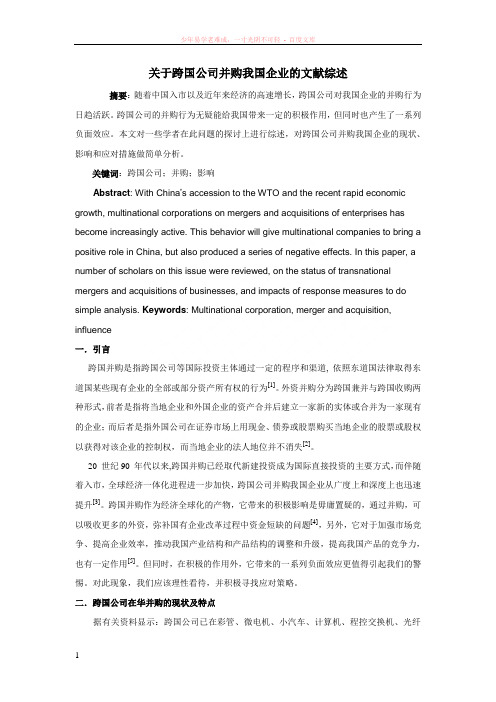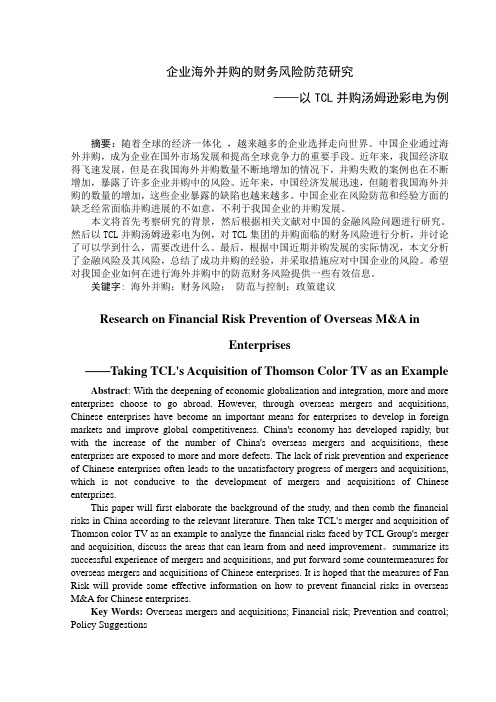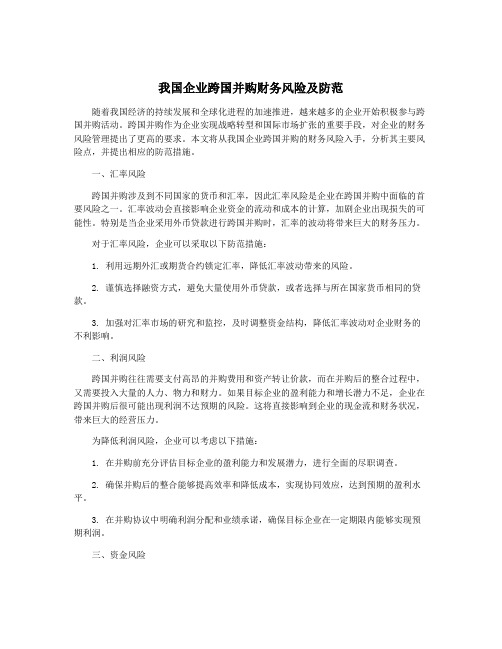中国企业跨国并购的财务风险(论文外文文献翻译)
关于跨国公司并购我国企业的文献综述

关于跨国公司并购我国企业的文献综述摘要:随着中国入市以及近年来经济的高速增长,跨国公司对我国企业的并购行为日趋活跃。
跨国公司的并购行为无疑能给我国带来一定的积极作用,但同时也产生了一系列负面效应。
本文对一些学者在此问题的探讨上进行综述,对跨国公司并购我国企业的现状、影响和应对措施做简单分析。
关键词:跨国公司;并购;影响Abstract: With China’s accession to the WTO and the recent rapid economic growth, multinational corporations on mergers and acquisitions of enterprises has become increasingly active. This behavior will give multinational companies to bring a positive role in China, but also produced a series of negative effects. In this paper, a number of scholars on this issue were reviewed, on the status of transnational mergers and acquisitions of businesses, and impacts of response measures to do simple analysis. Keywords: Multinational corporation, merger and acquisition, influence一.引言跨国并购是指跨国公司等国际投资主体通过一定的程序和渠道, 依照东道国法律取得东道国某些现有企业的全部或部分资产所有权的行为[1]。
外资并购分为跨国兼并与跨国收购两种形式,前者是指将当地企业和外国企业的资产合并后建立一家新的实体或合并为一家现有的企业;而后者是指外国公司在证券市场上用现金、债券或股票购买当地企业的股票或股权以获得对该企业的控制权,而当地企业的法人地位并不消失[2]。
中国企业跨国并购的财务风险探究

第1 页共20 页目录1.引言 (4)2.中国企业跨国并购及财务风险概述 (4)2.1并购与跨国并购 (4)2.2风险与财务风险 (5)2.3.跨国并购财务风险 (5)2.4中国企业跨国并购特点 (5)3.中国企业跨国并购财务风险的具体表现 (6)3.1 并购战略风险 (7)3.2 定价风险 (7)3.2.1 企业价值估计方法的局限性 (7)3.2.2 目标企业财务报表的真实性 (8)3.3 融资风险 (8)3.3.1 融资决策风险 (8)3.3.2 融资结构风险 (8)3.4 支付风险 (9)3.4.1 现金支付引发的流动性风险 (9)3.4.2 股权支付引发的股权稀释风险 (9)3.4.3 杠杆支付引发的偿债风险 (10)3.5 财务整合风险 (10)3.6 利率和汇率风险 (10)4. 中国企业跨国并购应对财务风险的举措 (11)4.1加强宏观调控,完善跨国并购的政策、法律体系 (11)4.2拓宽融资渠道 (12)4.3加快培养和利用为跨国并购服务的中介机构 (12)4.4重视并购人才队伍培养 (13)5.中国移动并购巴基斯坦paktel公司的财务风险控制 (13)5.1并购双方资料介绍 (13)5.2并购事件回顾 (14)5.3并购财务风险的防范 (14)5.4经验总结 (15)5.4.1明确的并购战略 (15)5.4.2要多方收集目标企业的信息 (15)5.4.3注意并购后对企业资本结构和现金流的影响 (16)结论 (17)致谢 (18)参考文献 (19)1.引言 (4)2.中国企业跨国并购及财务风险概述 (4)2.1并购与跨国并购 (4)2.2风险与财务风险 (5)2.3.跨国并购财务风险 (5)2.4中国企业跨国并购特点 (5)3.中国企业跨国并购财务风险的具体表现 (6)3.1 并购战略风险 (7)3.2 定价风险 (7)3.2.1 企业价值估计方法的局限性 (7)3.2.2 目标企业财务报表的真实性 (8)3.3 融资风险 (8)3.3.1 融资决策风险 (8)3.3.2 融资结构风险 (8)3.4 支付风险 (9)3.4.1 现金支付引发的流动性风险 (9)3.4.2 股权支付引发的股权稀释风险 (9)3.4.3 杠杆支付引发的偿债风险 (10)3.5 财务整合风险 (10)3.6 利率和汇率风险 (10)4. 中国企业跨国并购应对财务风险的举措 (11)4.1加强宏观调控,完善跨国并购的政策、法律体系 (11)4.2拓宽融资渠道 (12)4.3加快培养和利用为跨国并购服务的中介机构 (12)4.4重视并购人才队伍培养 (13)5.中国移动并购巴基斯坦paktel公司的财务风险控制 (13)5.1并购双方资料介绍 (13)5.2并购事件回顾 (14)5.3并购财务风险的防范 (14)5.4经验总结 (15)5.4.1明确的并购战略 (15)5.4.2要多方收集目标企业的信息 (15)5.4.3注意并购后对企业资本结构和现金流的影响 (16)结论 (17)致谢 (18)参考文献 (19)中国企业跨国并购的财务风险探究摘要近年,跨国并购已是当代企业国际拓展的重要形式之一,也是企业本身实现扩张发展的一项重要途径,随着经济全球一体化和信息技术的广泛应用,世界经济作为一个有机整体紧密联系。
企业海外并购的财务风险防范研究 —以TCL并购汤姆逊彩电为例-会计-毕业论文

企业海外并购的财务风险防范研究——以TCL并购汤姆逊彩电为例摘要:随着全球的经济一体化,越来越多的企业选择走向世界。
中国企业通过海外并购,成为企业在国外市场发展和提高全球竞争力的重要手段。
近年来,我国经济取得飞速发展,但是在我国海外并购数量不断地增加的情况下,并购失败的案例也在不断增加,暴露了许多企业并购中的风险。
近年来,中国经济发展迅速,但随着我国海外并购的数量的增加,这些企业暴露的缺陷也越来越多。
中国企业在风险防范和经验方面的缺乏经常面临并购进展的不如意,不利于我国企业的并购发展。
本文将首先考察研究的背景,然后根据相关文献对中国的金融风险问题进行研究。
然后以TCL并购汤姆逊彩电为例,对TCL集团的并购面临的财务风险进行分析,并讨论了可以学到什么,需要改进什么。
最后,根据中国近期并购发展的实际情况,本文分析了金融风险及其风险,总结了成功并购的经验,并采取措施应对中国企业的风险。
希望对我国企业如何在进行海外并购中的防范财务风险提供一些有效信息。
关键字:海外并购;财务风险;防范与控制;政策建议Research on Financial Risk Prevention of Overseas M&A inEnterprises——Taking TCL's Acquisition of Thomson Color TV as an Example Abstract: With the deepening of economic globalization and integration, more and more enterprises choose to go abroad.However, through overseas mergers and acquisitions, Chinese enterprises have become an important means for enterprises to develop in foreign markets and improve global competitiveness. China's economy has developed rapidly, but with the increase of the number of China's overseas mergers and acquisitions, these enterprises are exposed to more and more defects. The lack of risk prevention and experience of Chinese enterprises often leads to the unsatisfactory progress of mergers and acquisitions, which is not conducive to the development of mergers and acquisitions of Chinese enterprises.This paper will first elaborate the background of the study, and then comb the financial risks in China according to the relevant literature. Then take TCL's merger and acquisition of Thomson color TV as an example to analyze the financial risks faced by TCL Group's merger and acquisition, discuss the areas that can learn from and need improvement。
中国企业跨国并购的财务风险管理——以吉利集团跨国收购沃尔沃为例

中国企业跨国并购的财务风险管理——以吉利集团跨国收购沃尔沃为例中国企业在全球范围内开展跨国并购已经成为一种趋势。
尤其是吉利集团作为中国汽车行业的领军企业,其成功并购沃尔沃的案例引起了广泛关注。
然而,跨国并购面临着巨大的财务风险,中国企业需要有效的财务风险管理策略来确保并购的成功实施。
本文将以吉利集团收购沃尔沃为例,探讨中国企业跨国并购的财务风险管理。
首先,要认识到跨国并购涉及到不同国家的法律、规定和审计标准的差异。
这些差异可能会导致财务信息的不准确性和透明度降低。
因此,在进行跨国并购前,中国企业应该进行尽职调查,了解目标企业的财务状况和风险情况,以及涉及到的法律和制度要求。
同时,建立一个有效的财务尽职调查流程,确保从目标企业获取到准确的财务信息。
其次,外汇风险是跨国并购中的重要财务风险之一。
在吉利集团收购沃尔沃的案例中,外汇风险是一个重要的考虑因素。
由于收购价格是以欧元进行计价的,吉利集团面临着人民币兑欧元汇率波动的风险。
为了管理外汇风险,中国企业可以采取多种策略,如使用金融衍生品进行套期保值、储备外汇等手段,以减少外汇风险对并购造成的不利影响。
除了外汇风险,债务风险也是跨国并购中需要关注的财务风险之一。
在吉利集团收购沃尔沃的案例中,中国银行为其提供了融资支持,并且沃尔沃也保留了一部分债务。
中国企业在进行跨国并购时,应该充分考虑并妥善管理债务风险。
这可以通过准确评估目标企业的债务水平和偿还能力,以及建立合理的财务结构和资本结构来实现。
另外,合规风险也是跨国并购中需要关注的重要财务风险。
在吉利集团收购沃尔沃的过程中,合规风险是一个重要的考虑因素。
中国企业需要了解并遵守目标企业所在国家的法律和法规,确保并购过程的合规性。
此外,中国企业还需要与目标企业的管理团队保持紧密沟通,加强合规风险的管理和控制。
最后,中国企业在跨国并购中还需要关注并管理市场风险和声誉风险。
市场风险包括目标企业所处市场的竞争环境、市场需求的不确定性等因素,而声誉风险则涉及企业形象和信誉。
企业海外并购的财务风险分析

企业海外并购的财务风险分析一、引言2018年,在德勤最新发布的《开放新征程–德勤2018中国企业海外投资运營指南》中指出,在政府政策宏观背景下,依旧鼓励中国企业进行海外并购。
海外并购的成功取决于财务风险的管控。
因此,本文基于并购理论,以平安收购富通集团案例事件为例,充分结合理论与实践,深入挖掘案例事件中存在的财务风险以及产生该些财务风险的原因。
从案例事件中得出启示,并结合理论研究,为我国企业在海外并购时防范财务风险提供建议,以提高并购成功率。
二、文献综述海外并购财务风险一直以来都是国内外学者研究的热点问题,研究成果梳理如下:(1)海外并购财务风险来源方面并购前期并购方对目标企业未进行充分了解、双方企业战略管理不同、整合不充分(Mirvis,1992);并购双方企业战略不匹配(Hopkins,1999);资本结构(Mantccon,2009)。
(2)海外并购财务风险管理方面并购企业应通过各种途径尽可能的获取被并购企业的信息,重点考察其战略、内部控制是否有效以及预期整合效果是否满意等方面(Perry,2004);并购企业应以双方国家宏观环境为基础,进行与环境相适应的财务风险管理(Deng,2009);在整合阶段,应注重企业人员的整合(Bryson,2003);对并购前、并购中和并购后对风险的控制(Zongsheng Liu,2009);在整合阶段,人力资源负责人应该注重员工心理问题,引导他们积极乐观,凝心聚力,以实现企业价值最大化的目标(Sophic Mairc,Picrrc Collerette,2011);严厉打击并购国家的腐败行为(Maria Chiara Di Guardo,Emanucla Marrocu,Raffaclc Paci,2016)。
融资风险管理要考虑自身合理的资本结构;支付风险管理要注重自身稳定的现金流;并购后的整合风险管理要注重不同企业的企业文化融合,保证宏观环境平稳发展(王法毅,董丽,2018);合理评估目标企业价值,建立基础分析评估体系,完善价值评估方法系统;合理制定融资策略;选择恰当的支付方式;妥善处置整合风险(孙慧慧,李萱,2018);聘请专业机构避免定价风险、设计复杂交易框架避免融资风险、借助海外资本市场融资降低财务风险、利用各种衍生金融工具对冲汇率风险以及充分发挥协同效应降低整合风险(姜博文,2018);三、平安收购富通案例及分析1.并购过程中国平安急于海外扩张,于2006年年底,聘请专业人士摩根大通对富通集团进行长达一年的考察以及测算后,开始购买富通股票,最终,中国平安以大约238亿元人民币换取富通集团股份达4.99%,一跃成为富通集团单一的第一大股东;2008年6月,中国平安再度斥资购买了5%的股票。
我国企业跨国并购财务风险及防范

我国企业跨国并购财务风险及防范随着我国经济的持续发展和全球化进程的加速推进,越来越多的企业开始积极参与跨国并购活动。
跨国并购作为企业实现战略转型和国际市场扩张的重要手段,对企业的财务风险管理提出了更高的要求。
本文将从我国企业跨国并购的财务风险入手,分析其主要风险点,并提出相应的防范措施。
一、汇率风险跨国并购涉及到不同国家的货币和汇率,因此汇率风险是企业在跨国并购中面临的首要风险之一。
汇率波动会直接影响企业资金的流动和成本的计算,加剧企业出现损失的可能性。
特别是当企业采用外币贷款进行跨国并购时,汇率的波动将带来巨大的财务压力。
对于汇率风险,企业可以采取以下防范措施:1. 利用远期外汇或期货合约锁定汇率,降低汇率波动带来的风险。
2. 谨慎选择融资方式,避免大量使用外币贷款,或者选择与所在国家货币相同的贷款。
3. 加强对汇率市场的研究和监控,及时调整资金结构,降低汇率波动对企业财务的不利影响。
二、利润风险跨国并购往往需要支付高昂的并购费用和资产转让价款,而在并购后的整合过程中,又需要投入大量的人力、物力和财力。
如果目标企业的盈利能力和增长潜力不足,企业在跨国并购后很可能出现利润不达预期的风险。
这将直接影响到企业的现金流和财务状况,带来巨大的经营压力。
为降低利润风险,企业可以考虑以下措施:1. 在并购前充分评估目标企业的盈利能力和发展潜力,进行全面的尽职调查。
2. 确保并购后的整合能够提高效率和降低成本,实现协同效应,达到预期的盈利水平。
3. 在并购协议中明确利润分配和业绩承诺,确保目标企业在一定期限内能够实现预期利润。
三、资金风险跨国并购需要支付大额的资金,而且在并购后需要持续投入资金进行整合和扩张。
如果企业在并购过程中出现资金困难,将影响到并购的顺利进行和后续的发展。
特别是在经济不景气或行业竞争加剧的情况下,资金风险将更加突出。
为应对资金风险,企业可以采取以下对策:1. 积极开展融资渠道的多元化,多渠道筹集资金,分散融资风险。
企业跨国并购的财务风险分析及防范策略本科毕业论文
企业跨国并购的财务风险分析及防范策略摘要跨国并购隐藏着各种各样风险。
其中,财务风险是各种并购风险在价值量上的综合反映,是企业并购成功与否的重要影响因素。
跨国并购的财务风险是企业由于并购而涉及的各项财务活动引起的企业财务状况恶化或财务损失的不确定性。
企业跨国并购面临更加复杂的经营环境,跨国并购的财务风险比国内并购要大。
跨国并购的四种财务风险的特点,来源和形成阶段各不相同,具体表现在以下几个方面:目标价值评估风险主要来源于并购前对于目标企业的价值评估失败而引起的;融资风险是企业并购过程中筹集并购费用没有恰当选择筹资方式和筹资结构不合理引起的;支付风险是企业在并购中选择支付方式不当造成的;杠杆并购的偿债风险是并购前对自身评估不足,企业负债比例过高,以致经营过程中不足以支付债务本金和利息而引起的。
解决各种财务风险类型的防范策略主要有:目标价值评估风险要做好并购前的识别和有效管理;对于融资风险,企业要选择恰当的融资方式,科学运用“优先排序”理论,使企业综合资本结构最优化;对于支付风险,企业要严格编制资金预算,恰当选择各种支付方式特别是对混合支付方式的运用,合理安排支付时间;对于LBO并购的偿债风险,企业要根据企业自身的实际特点,调整企业的资本结构,选择企业可以承受的融资方案。
企业跨国并购的未来发展趋势是并购越来越倾向战略并购。
关键词:跨国并购 , 财务风险 , 风险分析 , 风险防范ABSTRACTTransnational m&a hide all kinds of risk. Among them, thefinancial risk is all sorts of m&a risk in value, is the comprehensive reflection of m&a important influence factors of success.The financial risk of the transnational merger and acquisition is due to the enterprise involved caused the financial activities of enterprise financial deterioration or financial loss of uncertainties. Enterprise transnational m&a face more complex business environment, the financial risk of the transnational merger and acquisition than domestic.Four kinds of transnational m&a financial risk characteristics, source and forming stages each are not identical, embodied in the following aspects: the target value appraisal risk mainly comes from before the acquisition of the target enterprise value appraisal for failure and cause; Financing risk is enterprise merger acquisition process of appropriate choice expenses not raise financing ways and financing structure caused by unreasonable; Payment risk is the enterprise in m&a improper choose payment; Leveraged acquisition debt risk is before the acquisition of their own assessment is insufficient, enterprise liabilities high proportion, so that the management process is not enough to pay for financing principal and interest and cause.Solve various financial risk type of preventive strategy mainly has: the target value appraisal risk to do before the acquisition of recognition and effective management; The risk for financing, the enterprises must choose appropriate scientific use of financing, prioritize "theory", make enterprise comprehensive capital structure optimization; For payment risk, the enterprise must strictly preparecapital budget, appropriate choice of various payment, especially the use of hybrid payment, arrange payment time; The risk for debt LBO merger, the enterprises must according to enterprise own actual characteristic, adjust enterprise's capital structure, choose enterprise can withstand financing plan.Enterprise transnational m&a trend of future development is increasingly likely that strategic acquisitions merger.Keywords: transnational M&A financial risk risk analysis risks prevention目录前言 (6)第一章企业跨国并购的风险概述 (6)1.1 企业跨国并购的现状 (7)1.2 企业跨国并购的风险类型 (7)1.2.1 跨国并购中的系统风险 (7)1.2.2 跨国并购中的非系统风险 (8)第二章企业跨国并购的财务风险分析 (10)2.1 目标企业价值评估风险分析 (10)2.1.1 并购双方之间信息不对称 (10)2.1.2 企业价值评估方法不恰当,评估体系不健全 (10)2.1.3 企业忽视中介组织的作用和利用不当 (10)2.2 融资风险分析 (11)2.2.1 企业的经营状况 (11)2.2.2 企业的资本结构 (11)2.2.3 汇率的变动 (11)2.3 支付风险分析 (11)2.3.1 现金支付 (12)2.3.2 股票交换 (12)2.3.3 债券支付 (12)2.3.4 综合证券支付 (12)2.4 杠杆收购的偿债风险分析 (12)2.4.1 收购时机和收购策略的运用带来的风险 (13)2.4.2 高息风险债券带来的风险 (13)2.4.3 收购资金中过高的负债比例带来的风险 (13)第三章企业跨国并购的财务风险的防范策略 (13)3.1 目标企业价值评估风险的防范策略 (14)3.1.1 目标企业价值评估风险的识别 (14)3.1.2 企业对目标价值评估风险的管理 (15)3.2 融资风险的防范策略 (15)3.2.1 各种融资方式进行成本分析 (16)3.2.2 并购融资方式选择过程 (16)3.2.3 融资结构规划 (16)3.3 支付风险的防范 (17)3.3.1 严格制定并购资金需要量及支出预算 (17)3.3.2 改进支付方式,降低支付风险 (17)3.4 杠杆并购的偿债风险的防范策略 (19)3.4.1 正确选择目标企业 (19)3.4.2 科学评估目标企业价值 (19)3.4.3 调整并购方资本结构 (19)3.4.4 合理设计筹资方案 (19)第四章企业跨国并购的展望 (19)小结 (20)参考文献 (21)前言21世纪以来,随着中国企业“走出去”战略的实施,跨国并购再次成为社会的一大热点。
《我国企业海外并购的财务风险及防范研究》
《我国企业海外并购的财务风险及防范研究》一、引言随着全球经济一体化的深入发展,我国企业海外并购已成为企业国际化发展的重要途径。
然而,海外并购过程中存在的财务风险不可忽视。
本文将针对我国企业海外并购的财务风险进行深入探讨,并提出相应的防范措施。
二、我国企业海外并购的财务风险1. 估值风险估值风险是企业在并购过程中最常见的财务风险。
由于信息不对称、文化差异、法律环境差异等因素,导致对目标企业的价值评估出现偏差,从而使得并购方支付过高的价格,造成财务风险。
2. 融资风险融资风险主要表现在并购过程中资金来源的不确定性和融资成本的高昂。
企业在进行海外并购时,往往需要大量的资金支持,如果融资渠道不畅或融资成本过高,将给企业带来巨大的财务压力。
3. 支付风险支付风险主要表现在并购后的支付方式和支付时间上。
如果支付方式选择不当或支付时间安排不合理,将影响企业的现金流状况,甚至可能导致企业资金链断裂。
4. 整合风险整合风险主要指并购完成后,企业在进行文化整合、业务整合、人员整合等方面的风险。
由于文化差异、管理差异等因素,可能导致整合过程出现困难,影响企业的运营效率。
三、防范措施1. 完善估值体系企业应建立完善的估值体系,对目标企业进行全面的价值评估。
在评估过程中,应充分考虑信息不对称、文化差异、法律环境差异等因素,确保估值的准确性。
同时,企业还可以引入第三方专业机构进行估值评估,以降低估值风险。
2. 拓宽融资渠道企业应积极拓宽融资渠道,降低融资成本。
除了银行贷款、债券发行等传统融资方式外,还可以考虑引入战略投资者、发行股票等多元化融资方式。
此外,企业还可以通过国际金融市场进行融资,以降低融资成本。
3. 合理选择支付方式企业应根据自身现金流状况、并购规模等因素,合理选择支付方式。
可以采取现金、股票、混合支付等方式,以降低支付风险。
同时,应合理安排支付时间,确保企业的现金流状况良好。
4. 加强整合管理企业应加强整合管理,制定详细的整合计划,明确整合目标、整合内容、整合时间等。
《我国企业跨国并购中的财务风险研究》
《我国企业跨国并购中的财务风险研究》一、引言随着经济全球化的深入发展,跨国并购已成为我国企业实现国际化战略的重要手段。
然而,跨国并购过程中,财务风险的存在和影响不容忽视。
本文旨在探讨我国企业在跨国并购过程中可能面临的财务风险,分析其成因及防范措施,以期为企业实施跨国并购提供有价值的参考。
二、我国企业跨国并购的背景及发展趋势随着我国经济的快速发展和国际地位的不断提升,我国企业跨国并购的规模和频率逐渐增加。
跨国并购不仅有助于企业快速扩大市场份额、获取先进技术和管理经验,还能提高企业的国际竞争力。
然而,跨国并购过程中,企业面临着诸多财务风险,如估值风险、融资风险、支付风险等。
三、我国企业跨国并购中的财务风险分析1. 估值风险估值风险是企业在跨国并购过程中面临的主要财务风险之一。
由于不同国家的会计准则、市场环境、文化背景等因素的差异,目标企业的估值往往存在不确定性。
此外,过高的估值可能导致企业支付过多,影响企业的财务状况。
2. 融资风险融资风险主要表现在企业并购过程中的资金筹集方面。
企业在跨国并购过程中需要大量的资金支持,而资金的来源和筹集方式的选择都会对企业的财务状况产生影响。
如果企业融资成本过高或融资渠道不畅,可能导致企业财务压力增大,甚至影响并购的顺利进行。
3. 支付风险支付风险主要指企业在跨国并购过程中的支付方式和支付时机选择不当所导致的风险。
不同的支付方式(如现金支付、股票支付等)和支付时机都可能对企业的财务状况产生不同程度的影响。
如果支付方式选择不当或支付时机把握不准确,可能导致企业资金链紧张或支付成本过高。
四、财务风险成因分析1. 信息不对称信息不对称是导致企业跨国并购财务风险的重要原因之一。
由于目标企业的财务状况、经营成果、市场前景等信息可能存在不透明或虚假的情况,导致并购企业对目标企业的价值评估存在误差,从而产生财务风险。
2. 法律法规差异不同国家的法律法规存在差异,企业在跨国并购过程中需要了解和遵守当地的法律法规。
中国企业跨国并购的财务风险分析及防范
中国企业跨国并购的财务风险分析及防范随着中国经济的快速发展和海外市场的日益开放,中国企业跨国并购的数量和规模不断扩大。
然而,这种形式的扩张也面临着许多财务风险。
首先,汇率风险是跨国并购中最主要的风险之一。
由于不同国家的货币价值存在波动性,当一个中国企业购买海外企业时,将会涉及到不同货币之间的兑换。
如果购买时汇率不稳定,在交易完成后,汇率波动可能会导致交易收益与预期不符。
因此,企业应该尽可能采取措施,例如在购买前准确计算企业价值,并采用风险管理工具,如货币对冲和外汇掉期等来管理汇率风险。
其次,财务报表风险也是跨国并购中的另一个关键风险。
中国企业与海外企业在财务报表采用的会计准则和财务报告形式上存在巨大差异。
有效的财务尽职调查和详细的财务分析是避免这种风险的关键。
企业应该委托专业的会计师事务所或财务顾问进行尽职调查,详细分析目标企业的财务报表,并了解目标企业的利润、现金流和资本结构等情况。
另外,政策风险也是跨国并购的一个重要风险。
许多国家的法律、法规、政策以及商业环境都存在较大的差异。
对于中国企业来说,海外市场的监管和法律体系可能会对企业进行限制和制约。
因此,企业应该充分了解目标企业所处的国家的法律、政策和商业环境,积极保持沟通,并采取相应措施,以免受到政策风险的影响。
最后,管理风险是跨国并购中难以避免的一个风险。
并购后,管理层和员工的组合、文化差异、语言障碍等因素都可能导致整合管理过程中出现各种问题。
为了缓解管理风险,企业应该充分协调各方的利益,构建合理的人才培养计划和充分的沟通机制,以确保并购后双方能够更好地协同工作。
综上所述,中国企业跨国并购的财务风险不可避免,但企业可以通过有效的风险管理和实施相应的风险防范措施来减轻风险。
企业应该尽可能详细地了解目标企业的财务状况和商业环境,并尽可能调动各方的资源和力量,以确保并购项目的成功实施。
- 1、下载文档前请自行甄别文档内容的完整性,平台不提供额外的编辑、内容补充、找答案等附加服务。
- 2、"仅部分预览"的文档,不可在线预览部分如存在完整性等问题,可反馈申请退款(可完整预览的文档不适用该条件!)。
- 3、如文档侵犯您的权益,请联系客服反馈,我们会尽快为您处理(人工客服工作时间:9:00-18:30)。
1 Financial Risks of Chinese Enterprises’ Cross-Border Mergers and Acquisitions
Abstract With overall strength of Chinese enterprises and national going out strategy, cross-border M & As initiated by Chinese enterprises have been booming. However, compared with developed countries, Chinese enterprises started their M & As late and lacked experience and professionals. As a result, Chinese enterprises faced with numerous risks in cross-border M & As, especially with the financial risks. This paper, based on the analysis of Chinese enterprises’ cross-border M & As cases in recent years, explained how the financial risks formed and finally came up with efficacious precautionary measures.
Key words: Chinese enterprise; M & As; Financial; risks
1. OVERVIEW OF FINANCIAL RISKS OF CROSS-BORDER M & AS Financial risks refer to the reimbursement risks and change of returns to shareholders triggered by financing decision in the process of enterprises’ cross-border mergers and acquisitions (abbr. M & As). Enterprises often go through three phases—valuation, financing, and payment—in the process of cross-border M & As. Based on valuation, financing, and payment, decisions affect enterprises’ assets structure and even their solvency and returns to their shareholders. In addition, cross-border M& As use an international currency for most countries.Change in exchange rates affects corporate earnings, as well as shareholders’ returns. Therefore, there are four main types of financial risks: valuation risk, financing risk, payment risk, and exchange rate risk.
2. STATUS OF CHINESE ENTERPRISES’ CROSS-BORDER M & AS Combining with going out strategy, Chinese enterprises upgrade their strength and participate in the context of economic globalization. Chinese enterprises begin to go abroad, merging and acquiring foreign ones. Although Chinese enterprises’ cross-border M & As started late, China has become the world’s fifth cross-border acquiring power in 2009. Status of Chinese enterprises’ cross-border M & As is as follows: 2
2.1 Increases in the Number and Scale of M & As In the year of 2008, Chinese companies completed only 30 cases of cross-border M & As, costing less than $ 9 billion. In the year of 2013, Chinese companies completed 99 cross-border M & A, amounting to $ 38.5 billion. The number of M & As doubled, while the total amount grew more than three times.
2.2 Large State-Owned Enterprises as M & As Subject Compared with private enterprises, large state-owned enterprises have more their own capital. It is easy for them to get loans and finance, so Chinese cross-border M & As are mostly done by large state-owned enterprises. On the Summer Davos Forum in 2013, Andrew, Global Chairman of KPMG International, pointed out that 86% of the China’s foreign investment came from China’s state-owned enterprises. By far in China, the largest cross-border M & As was initiated by China’s state-owned enterprises CNOOC. On February 27, 2013, CNOOC successfully acquired Nexen Corp., a Canadian company, by spending $ 15.1 billion.
2.3 Cash as the Main Form of Payment China’s market economy status has not been recognized by all countries, and, to a certain extent, Chinese enterprises are discriminated in cross-border M & As. In addition, China’s financial market is not perfect. In order to gain direct control of the acquired enterprises, Chinese enterprises mostly pay by cash. According to Bloomberg, 79.4% of China’s cross-border M & As made their payment by cash, 3.3% by stock, and only 1.18% by other mode.
2.4 Increased Impact of Exchange Rate on M & As Before the year of 2012, the floating range of RMB against U.S. dollar was only 0.5%. Since 2012, China’s central bank adjusted the floating range of RMB against U.S. dollar to 1%, and on March 15, 2014, extended it to 2%. Compared to the previous fixed exchange rate, the change of exchange rate significantly increased, which made the Chinese enterprises begin to consider the impact of exchange rate change on acquisition costs in their M & As.
3. FINANCIAL RISKS FACED WITH CHINESE ENTERPRISES IN CROSSBORDER M & AS Chinese enterprises began to participate in cross-border M & As actively only in the past ten years. The lack of experience made it difficult to accurately value the target enterprises. China’s financial market is not mature, it is difficult for Chinese enterprises to finance and choose payment mode. At the same time, the international financial market fluctuates, and RMB is not an international monetary.
